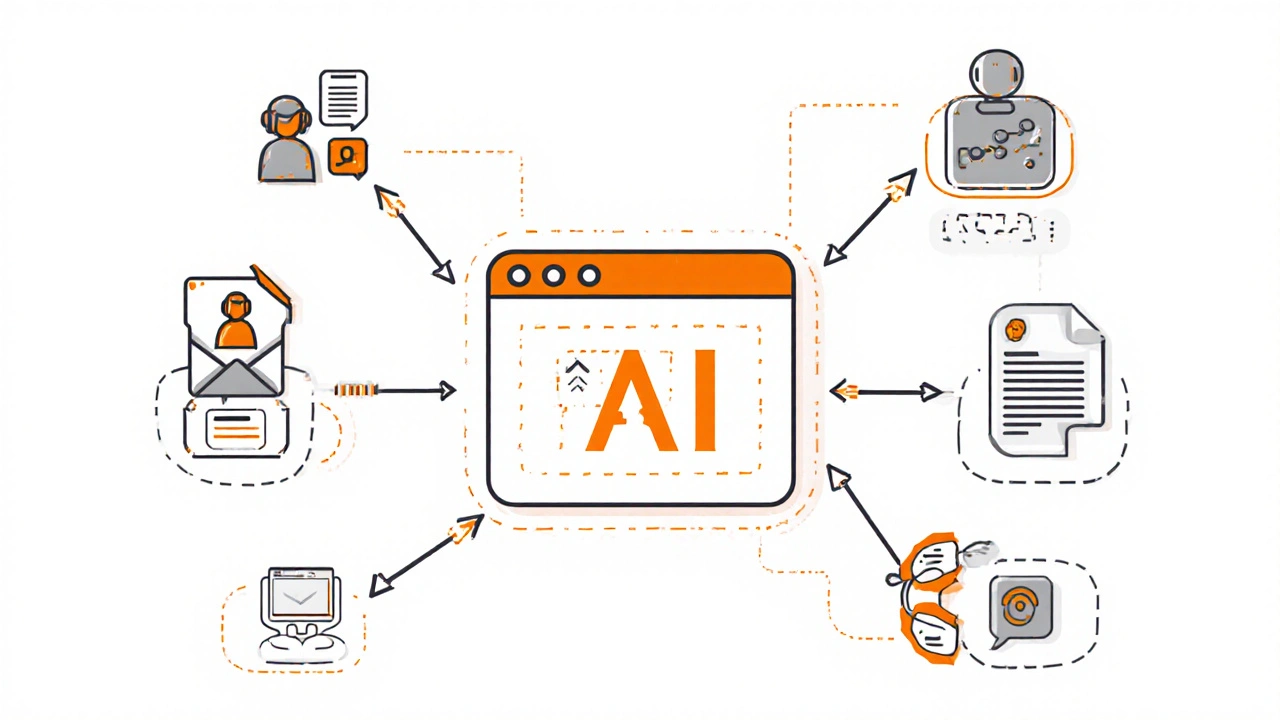ChatGPT Prompt Builder
Build Your Custom Prompt
Create powerful ChatGPT prompts with specific context and structure
Example: "Write 5 email subject lines for eco-friendly cleaning products targeting Brisbane mums. Use friendly, casual tone (no jargon). Max 10 words. Include examples of past high-performing subject lines: 'Your cleaning routine just got easier!' and 'No more chemical worries for your family'"
Most digital marketers still treat AI like a fancy tool you plug in once a week to generate blog ideas. That’s like using a jet engine to power a bicycle. ChatGPT isn’t just another plugin-it’s rewriting how campaigns are built, tested, and scaled. If you’re still manually writing ad copy, scheduling social posts, or guessing what your audience wants, you’re already behind.
ChatGPT Isn’t Just for Writing Blog Posts
People think ChatGPT’s main job is to spit out articles. But that’s the smallest part of what it can do. Real digital marketers use it to generate hundreds of variations of email subject lines in under a minute. They feed it past campaign data and ask: ‘Which of these three headlines performed best with women aged 35-44 in Australia last quarter?’ It doesn’t guess-it analyzes patterns from your own data.
One Brisbane-based e-commerce brand used ChatGPT to test 500 different Facebook ad variations for a new skincare line. Instead of spending weeks on A/B testing, they ran 20 variants per day for three days. ChatGPT flagged the top three based on engagement trends from their CRM. Result? A 47% increase in click-through rate and 32% lower cost per acquisition. That’s not luck. That’s data-driven AI.
Personalization at Scale, Without Hiring a Team
Personalization used to mean hiring copywriters to write 10 different versions of a welcome email. Now, ChatGPT can generate 10,000. You feed it customer segments-‘users who abandoned carts in the last 7 days’, ‘repeat buyers who haven’t purchased in 60 days’, ‘first-time visitors from Brisbane’-and it writes tailored messages that sound human.
One SaaS company in Melbourne automated their onboarding sequence. Instead of a generic ‘Thanks for signing up!’ email, ChatGPT pulls from user behavior: if someone watched the tutorial video, it says ‘You’re already ahead-here’s how to unlock the next feature.’ If they skipped it, it says ‘Still figuring it out? Here’s a 90-second walkthrough.’ Response rates jumped 68%. No A/B testing. No guesswork. Just context-aware messaging.
Turning Customer Service Into a Marketing Engine
Most brands treat support as a cost center. ChatGPT turns it into a lead generator. When a customer asks, ‘Can this tool integrate with Shopify?’, the AI doesn’t just answer-it adds: ‘Many of our Shopify users also use Klaviyo for email. Here’s a free template to sync them.’
A fitness app in Sydney used this approach. Their ChatGPT-powered chatbot now asks follow-up questions after support tickets: ‘Are you using this for personal training or group classes?’ Based on the answer, it recommends relevant content, upsells a premium plan, or sends a case study. Conversion from support chats to paid upgrades increased by 51% in two months.

Content That Actually Ranks (Without the SEO Guesswork)
You don’t need to be an SEO expert to write content that ranks. ChatGPT can analyze top-ranking pages for your target keyword and tell you exactly what’s missing. Ask it: ‘What are the top 5 articles ranking for “best CRM for small business Australia”? What questions do they answer that the others don’t?’
One local agency used this to rewrite a blog post targeting ‘email marketing tools for startups’. The original post covered 12 tools. ChatGPT pulled insights from the top 3 articles and found none mentioned integration with Australian tax software like Xero. They added a section comparing each tool’s Xero sync capability. The post jumped from page 3 to number one in two weeks.
Real-Time Campaign Optimization, Not Just Reporting
Most marketers check analytics once a week. ChatGPT can tell you what to change today. Feed it your Google Ads data, your social metrics, and your website bounce rates. Then ask: ‘Why did our cost per lead spike last Tuesday? What should we pause or double down on?’
A digital agency in Brisbane ran this experiment: every morning, ChatGPT scanned their last 24 hours of campaign data and sent a one-paragraph summary with three actionable fixes. One day, it flagged that Instagram Reels ads targeting 25-34-year-old men were getting 3x more saves than clicks. They changed the CTA from ‘Learn More’ to ‘Save this for later’ and watched conversion rates climb.
It’s Not About Replacing Humans-It’s About Amplifying Them
Some fear AI will take over marketing jobs. The truth? It’s replacing the boring stuff so humans can do the creative stuff. ChatGPT doesn’t come up with brand voices. You do. It doesn’t know your customer’s pain points. You do. It doesn’t understand your company’s soul. You do.
Think of it like a co-pilot. Your job is to steer. ChatGPT handles the fuel, the altitudes, the turbulence reports. A marketer who uses ChatGPT to draft 80% of their content, then spends 20% refining tone, adding personality, and testing emotional hooks, outperforms someone who writes everything manually.

Where Most Marketers Fail With ChatGPT
Most people fail because they treat it like a magic box. You don’t just type ‘write me a marketing email’ and get gold. You need structure.
- Give it context: ‘We sell organic dog food in Brisbane. Our customers care about grain-free ingredients and vet approval.’
- Give it constraints: ‘Write in a friendly, conversational tone. No jargon. Under 120 words.’
- Give it examples: ‘Here’s a past email that got a 28% open rate. Make another one like it.’
- Always edit: ChatGPT is great at patterns, bad at nuance. It won’t know your brand’s inside joke.
One team kept asking for ‘better social posts’ and got generic fluff. Then they started feeding it their best-performing posts from the last year. Suddenly, the output matched their voice. The difference? Specificity.
What’s Next? The AI-Driven Marketing Stack
ChatGPT doesn’t work alone. The best marketers are connecting it to their tools:
- CRM data → personalized email flows
- Google Analytics → real-time campaign tweaks
- Shopify product feeds → dynamic ad copy
- Customer reviews → sentiment analysis for new messaging
In 2025, the winners aren’t the ones using AI. They’re the ones who built systems where AI handles repetition, humans handle strategy, and data drives every decision.
Can ChatGPT replace my digital marketing team?
No. ChatGPT automates repetitive tasks like drafting emails, generating ad variations, or analyzing campaign data-but it can’t replace strategy, creativity, or emotional intelligence. Your team still decides what to say, who to target, and why it matters. ChatGPT just does the heavy lifting so your team can focus on high-value decisions.
Do I need technical skills to use ChatGPT for marketing?
No. You don’t need to code or understand APIs. If you can type a clear request-like ‘Write five email subject lines for a sale on running shoes targeting women over 40’-you can use ChatGPT effectively. The key isn’t technical skill, it’s asking the right questions. Start simple, then get more specific as you learn.
Is ChatGPT better than other AI tools for marketing?
ChatGPT stands out because it’s flexible. Unlike tools built for one task-like Jasper for ads or Copy.ai for emails-ChatGPT can handle content, analysis, automation, and even customer service scripts. It integrates easily with most platforms. That said, if you only need ad copy, a specialized tool might be faster. But for marketers who want one tool to do many things, ChatGPT is the most versatile option available today.
How do I make sure ChatGPT’s content sounds like my brand?
Feed it your best content. Give it three past blog posts, three top-performing emails, and one brand voice guide. Ask: ‘Rewrite this draft to match the tone of these examples.’ Over time, it learns your style-word choice, sentence length, humor level. Keep refining prompts until the output feels like it came from your team.
Is using ChatGPT for marketing ethical?
Yes-if you’re transparent and responsible. Don’t use it to fake reviews, manipulate search results, or mislead customers. Always edit output for accuracy. Disclose AI use if required by law or platform rules (like Meta’s disclosure policies). Ethical AI marketing means using it to help, not deceive. Your customers care more about honesty than whether a message was written by a human or AI.
What’s the biggest mistake marketers make when starting with ChatGPT?
Expecting perfect results on the first try. ChatGPT is a tool, not a wizard. The first draft will be generic. The second will be better. By the fifth prompt, with clear context and examples, you’ll get output that feels authentic. The key is iteration. Treat it like a junior team member who needs coaching-not a magic button.
Where to Start Today
Don’t wait for the perfect plan. Start small. Pick one task you hate doing-maybe writing email subject lines, or replying to common customer questions-and automate it with ChatGPT. Use this formula:
- What’s the task? (e.g., ‘Write 10 email subject lines for a 20% off sale’)
- What’s the context? (e.g., ‘We sell eco-friendly cleaning products to mums in Brisbane’)
- What’s the tone? (e.g., ‘Friendly, slightly playful, no jargon’)
- What’s the goal? (e.g., ‘High open rate, under 10 words’)
Run it. Edit it. Use it. Then repeat. In 30 days, you’ll be doing more with less. And that’s the real game-changer.





